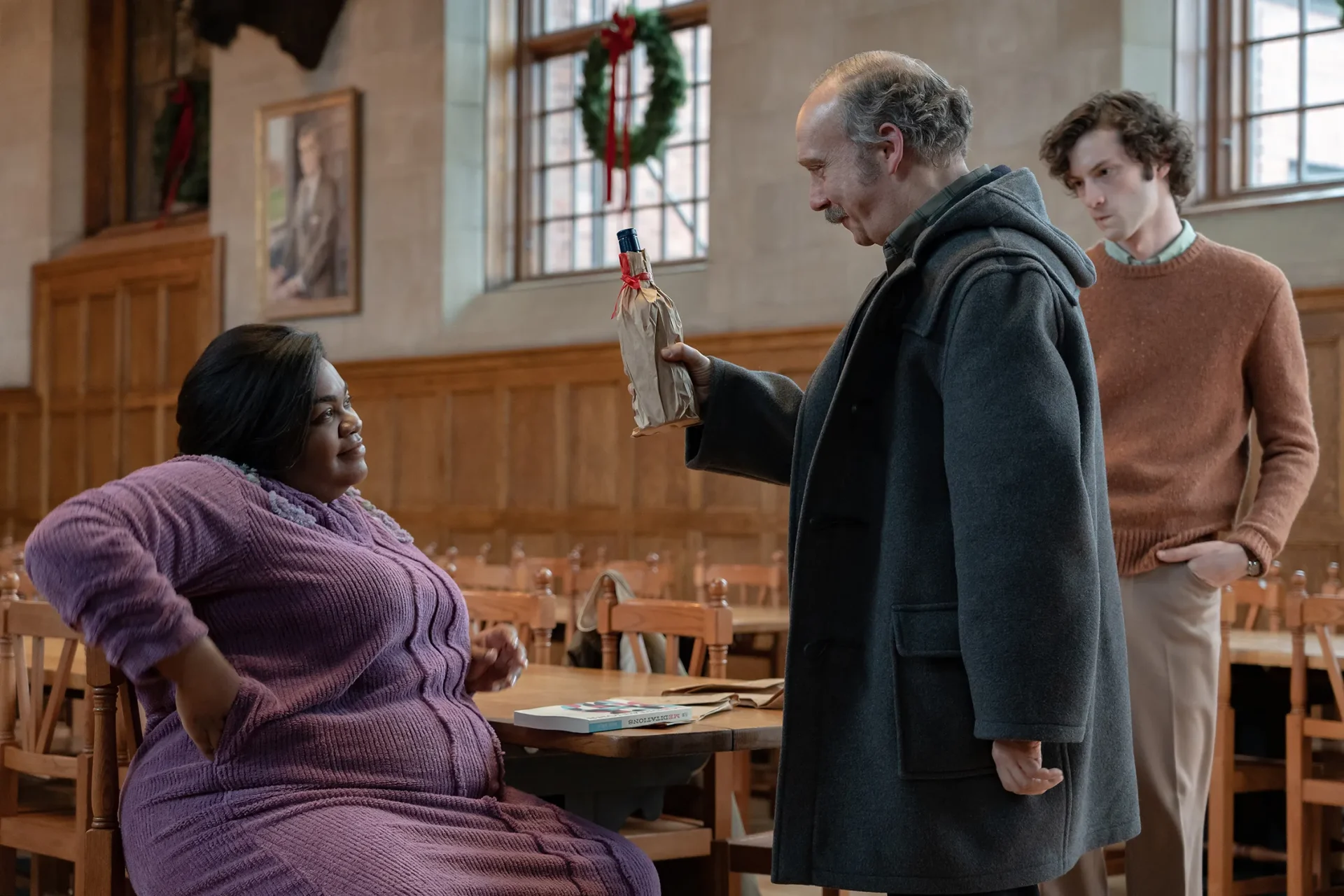“The Holdovers,” the latest feature from “Sideways” and “Nebraska” director Alexander Payne, is an absolute gift of a film that wraps a deeply resonant thematic throughline in superb comedic performances and ties it all together with interesting aesthetic choices that perfect the package. If you think this analogy sounds cheesy, perhaps the film, which adopts somewhat formulaic beats to construct a fairly typical Christmas romp, may not entirely work for you. However, it’s difficult to take away nothing from a piece of filmmaking made with this much joy and passion for the craft.
Paul Giamatti masters the assignment as Paul Hunham, a lonely classics teacher at a private boarding school who must oversee a group of students unable to return home for the holidays. His facial expressions and refined use of tone create a very believable, very human character, equal parts relatable and hilarious, whose transformation throughout the film feels earned. He is aided by newcomer Dominic Sessa, who portrays Angus Tully, a “holdover” pupil who develops a strikingly real bond with his teacher.
Sessa displays incredible maturity for an actor of his age and limited experience, possessing star quality and charisma to match that of the veteran Giamatti. Everyone should follow his career closely, given both the dramatic and comedic versatility he demonstrates here. The cast is rounded out by Da’Vine Joy Randolph as Mary Lamb, whose subplot of coming to terms with the recent death of her son, killed in the Vietnam War, provides one of the film’s most emotionally resonant moments. It is not in the individual performances themselves that the film really shines; it is the performances in conjunction with one another that make the movie special. Each of the three in this tight-knit ensemble provides a different energy yet brings out the best in one another – as families, natural or chosen, should.
Exploring two key themes – loneliness and being stuck in the past – the film arrives at the poignant thesis that fulfillment comes from appreciating the people we have around us in the present. Hunham may rather have an actual family, Tully may rather be with his parents over the holidays, and Lamb may rather be with her son, but sometimes we don’t get that choice. The Christmas period, so focused on ideals of familial connections, is hard for many people who don’t feel they have any. Still, the film teaches the audience that they should endeavor to find them nonetheless, as perhaps these connections are in the places we least expect.
While “The Holdovers” doesn’t deliver this message subtly, it is ironically in the subtle and quiet moments shared between the cast that their camaraderie comes to the forefront. We begin to understand their need for one another, moments in which the showy screenplay subsides and instead treats us to characters simply watching television or eating together.

“The Holdovers” constructs its comedy carefully, especially between Hunham and Tully. Their hilarious animosity towards one another never comes from a place of true malice. Throughout the film, we learn how these two function and how they are only pushing each other away because they are scared of the possible connection forming, a connection that has only left them disappointed in the past. Any film that tries to tell a slow-burn story of the connection between mismatched individuals, whether it’s a rom-com, marital drama, or coming-of-age tale, must do so with credibility and even-handedness. The screenplay by David Hemingson, the direction by Payne, and, of course, the performances all mesh to achieve this spectacularly.
At 133 minutes, “The Holdovers” is a breezy watch, helped by a retro aesthetic that not only further develops the themes but makes the film feel cinematic. As a 1970s time capsule, the visual choice relates to the sense of being stuck in the past, affecting the three leads, and lends the film a timeless quality. We may have seen this story before, but that’s kind of the point. The ideas it explores are always relevant, and the messages are always worth reiterating. Divorcing itself from modern filmmaking techniques and practices with such masterful care means Payne embeds universal human emotion into every moment as we face the idea we always have always needed and continue to need the same thing in life – people to call family.
It’s difficult to quantify what I mean when I say the film “feels like Christmas.” But the sheer joy etched into every frame, from the snowy New England production design to the tender performances, makes a film that could’ve been derivative into something far greater. The skill demonstrated by everyone in front of and behind the camera makes “The Holdovers” an instant comfort classic. Though I would implore you to check it out in a theatre, I would also argue that the movie works just as well, if not better, at home after Christmas dinner in the company of your loved ones. Add “The Holdovers” to any Christmas watchlist; you’ll not only be swept up in its magic, but you might just come to appreciate those around you a little bit more.






![God of Dreams [2022] Review: An Hodge-podge of several Dystopian fictional tales](http://www.highonfilms.com/wp-content/uploads/2022/02/God-of-Dreams-2022-768x432.jpg)
![Anomalisa [2015]: Catharsis on being and love](http://www.highonfilms.com/wp-content/uploads/2016/01/Anomalisa-2.jpg)
